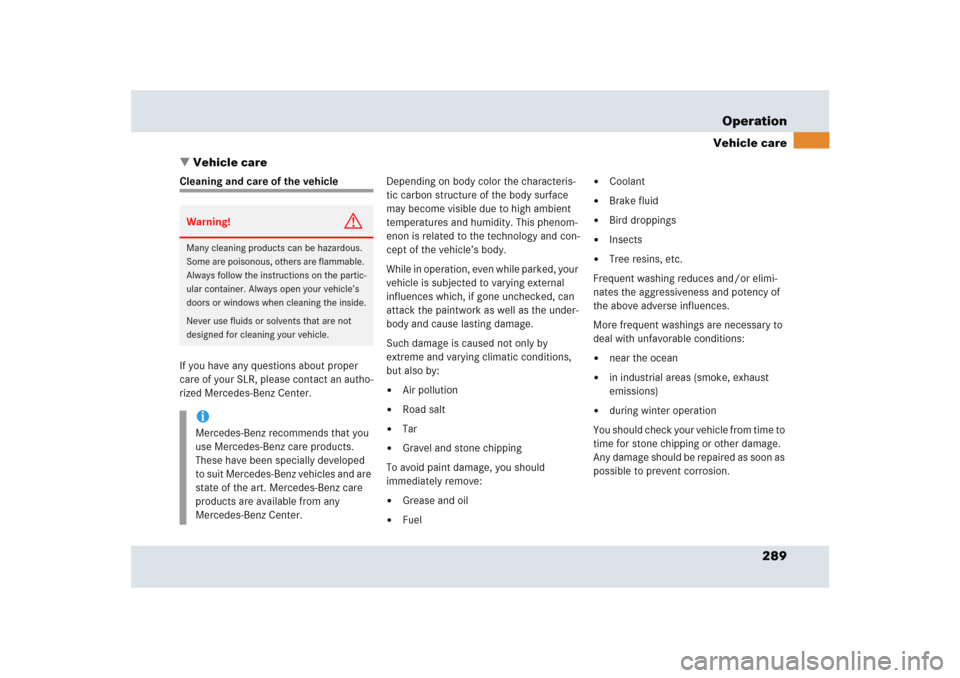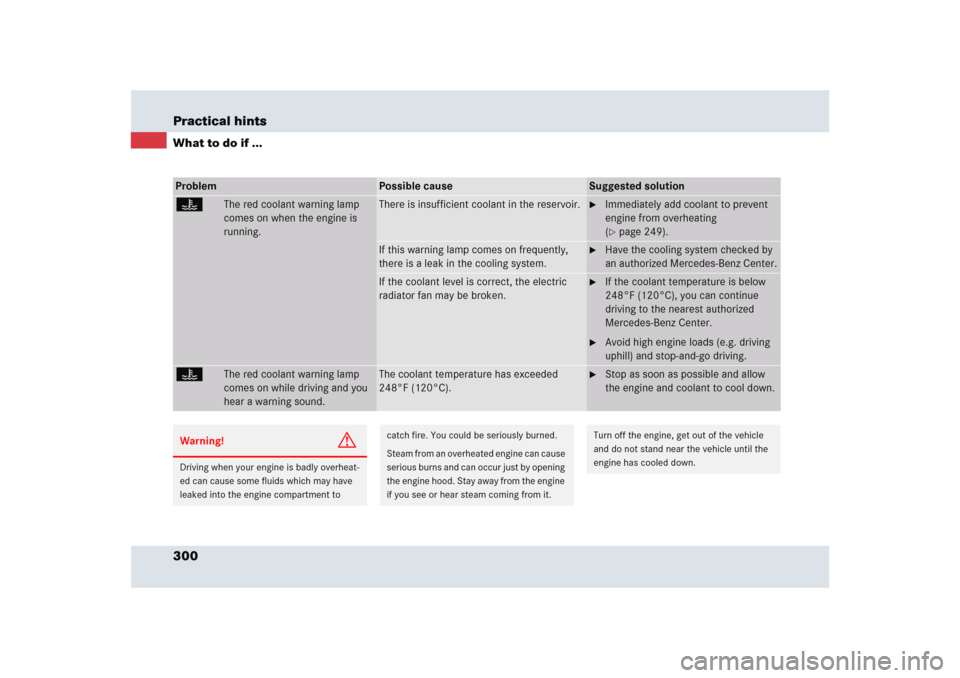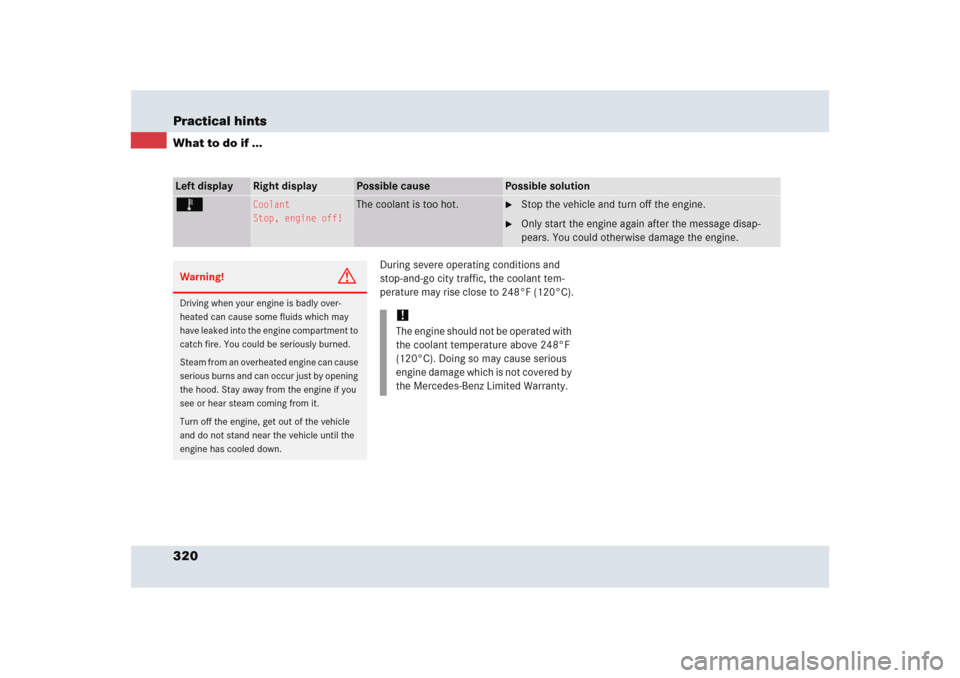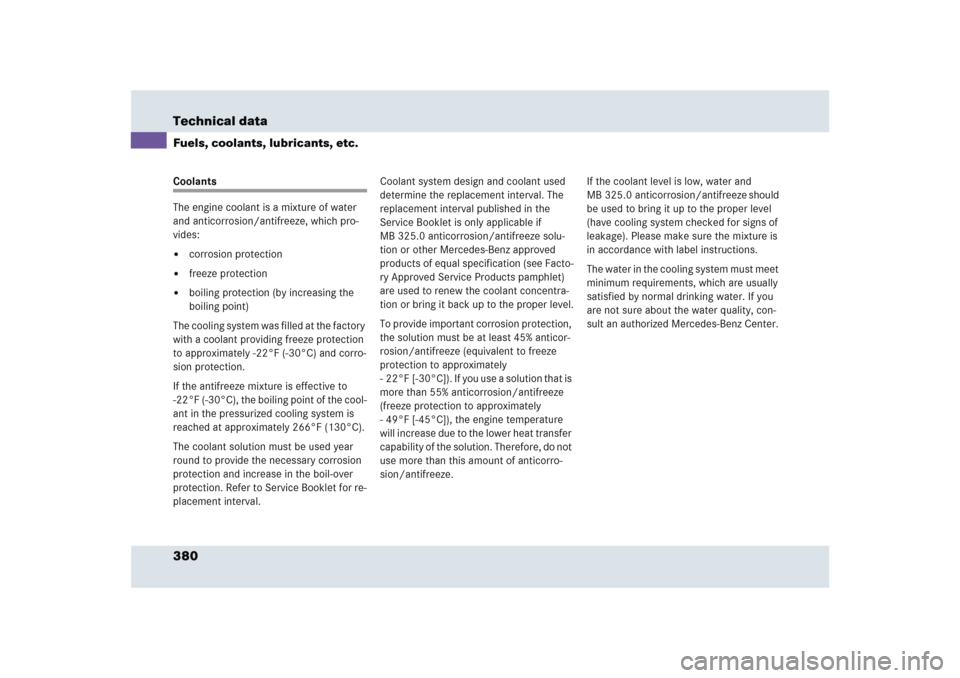Page 290 of 417

289 Operation
Vehicle care
�Vehicle care
Cleaning and care of the vehicle
If you have any questions about proper
care of your SLR, please contact an autho-
rized Mercedes-Benz Center.Depending on body color the characteris-
tic carbon structure of the body surface
may become visible due to high ambient
temperatures and humidity. This phenom-
enon is related to the technology and con-
cept of the vehicle’s body.
While in operation, even while parked, your
vehicle is subjected to varying external
influences which, if gone unchecked, can
attack the paintwork as well as the under-
body and cause lasting damage.
Such damage is caused not only by
extreme and varying climatic conditions,
but also by:
�
Air pollution
�
Road salt
�
Tar
�
Gravel and stone chipping
To avoid paint damage, you should
immediately remove:
�
Grease and oil
�
Fuel
�
Coolant
�
Brake fluid
�
Bird droppings
�
Insects
�
Tree resins, etc.
Frequent washing reduces and/or elimi-
nates the aggressiveness and potency of
the above adverse influences.
More frequent washings are necessary to
deal with unfavorable conditions:
�
near the ocean
�
in industrial areas (smoke, exhaust
emissions)
�
during winter operation
You should check your vehicle from time to
time for stone chipping or other damage.
Any damage should be repaired as soon as
possible to prevent corrosion.
Warning!
G
Many cleaning products can be hazardous.
Some are poisonous, others are flammable.
Always follow the instructions on the partic-
ular container. Always open your vehicle’s
doors or windows when cleaning the inside.
Never use fluids or solvents that are not
designed for cleaning your vehicle.iMercedes-Benz recommends that you
use Mercedes-Benz care products.
These have been specially developed
to suit Mercedes-Benz vehicles and are
state of the art. Mercedes-Benz care
products are available from any
Mercedes-Benz Center.
Page 301 of 417

300 Practical hintsWhat to do if ...Problem
Possible cause
Suggested solution
D
The red coolant warning lamp
comes on when the engine is
running.
There is insufficient coolant in the reservoir.
�
Immediately add coolant to prevent
engine from overheating
(�page 249).
If this warning lamp comes on frequently,
there is a leak in the cooling system.
�
Have the cooling system checked by
an authorized Mercedes-Benz Center.
If the coolant level is correct, the electric
radiator fan may be broken.
�
If the coolant temperature is below
248°F (120°C), you can continue
driving to the nearest authorized
Mercedes-Benz Center.
�
Avoid high engine loads (e.g. driving
uphill) and stop-and-go driving.
D
The red coolant warning lamp
comes on while driving and you
hear a warning sound.
The coolant temperature has exceeded
248°F (120°C).
�
Stop as soon as possible and allow
the engine and coolant to cool down.
Warning!
G
Driving when your engine is badly overheat-
ed can cause some fluids which may have
leaked into the engine compartment to
catch fire. You could be seriously burned.
Steam from an overheated engine can cause
serious burns and can occur just by opening
the engine hood. Stay away from the engine
if you see or hear steam coming from it.
Turn off the engine, get out of the vehicle
and do not stand near the vehicle until the
engine has cooled down.
Page 321 of 417

320 Practical hintsWhat to do if ...
During severe operating conditions and
stop-and-go city traffic, the coolant tem-
perature may rise close to 248°F (120°C).
Left display
Right display
Possible cause
Possible solution
Ï
Coolant
Stop, engine off!
The coolant is too hot.
�
Stop the vehicle and turn off the engine.
�
Only start the engine again after the message disap-
pears. You could otherwise damage the engine.
Warning!
G
Driving when your engine is badly over-
heated can cause some fluids which may
have leaked into the engine compartment to
catch fire. You could be seriously burned.
Steam from an overheated engine can cause
serious burns and can occur just by opening
the hood. Stay away from the engine if you
see or hear steam coming from it.
Turn off the engine, get out of the vehicle
and do not stand near the vehicle until the
engine has cooled down.
!The engine should not be operated with
the coolant temperature above 248°F
(120°C). Doing so may cause serious
engine damage which is not covered by
the Mercedes-Benz Limited Warranty.
Page 322 of 417
321 Practical hints
What to do if ...
Left display
Right display
Possible cause
Possible solution
Ï
Coolant
Stop, engine off!
The poly-V-belt could be bro-
ken.
�
Stop immediately and check the poly-V-belt.
If it is broken:
�
Do not continue to drive. Otherwise the engine will over-
heat due to an inoperative water pump which may result
in damage to the engine. Notify an authorized
Mercedes-Benz Center.
If it is intact:
�
Do not continue to drive with this message displayed.
Doing so could result in serious engine damage that is
not covered by the Mercedes-Benz Limited Warranty.
�
Observe the coolant temperature gauge in the instru-
ment cluster (
�page 29).
�
Drive immediately to the nearest authorized
Mercedes-Benz Center.
Coolant
Visit
workshop!
The cooling fan for the coolant
is malfunctioning.
�
Observe the coolant temperature gauge in the instru-
ment cluster (
�page 29).
�
Have the fan replaced immediately.
Page 330 of 417
329 Practical hints
What to do if ...
Left display
Right display
Possible cause
Possible solution
±
Display malfunc-
tion
Visit
workshop!
Certain electronic systems are
unable to relay information to
the control system. The follow-
ing systems may have failed:�
Coolant temperature gauge
�
Tachometer
�
Cruise control display
�
Have the electronic systems checked by an authorized
Mercedes-Benz Center immediately.
Fuel system
malfunction
Visit
workshop!
The fuel cooling system is
malfunctioning.
�
Visit an authorized Mercedes-Benz Center immediately.
Page 376 of 417
375 Technical data
Fuels, coolants, lubricants, etc.
�Fuels, coolants, lubricants, etc.
CapacitiesVehicle components and their respective
lubricants must match. Therefore use only
products tested and approved by
Mercedes-Benz. Please refer to the Factory Approved
Service Products pamphlet, or inquire at
your Mercedes-Benz Center.
Capacity
Fuels, coolants, lubricants, etc.
Engine with oil filter
9.5 US qt (9.0 l)
Approved engine oils
Automatic transmission
9.1 US qt (8.6 l)
MB Automatic Transmission Fluid
Rear axle
1.9 US qt (1.8 l)
Hypoid gear oil SAE 75 W 85
Power steering
approximately 1.15 US qt (1.1 l)
MB Power Steering Fluid (Pentosin CHF 11S)
Front wheel hubs
approximately 3.0 oz (85 g) each
High temperature roller bearing grease
Brake system
1.6 US qt (1.5 l)
MB Brake Fluid (DOT 4+)
Page 377 of 417
376 Technical dataFuels, coolants, lubricants, etc.
Capacity
Fuels, coolants, lubricants, etc.
Cooling system
approximately 10.6 US qt (10.0 l)
MB 325.0 Anticorrosion/Antifreeze
Low temperature cooling system
approximately 5.3 US qt (5.0 l)
MB 325.0 Anticorrosion/Antifreeze
Fuel tank
including a reserve of
25.6 US gal (97.0 l)
3.2 US gal (12.0 l)
Premium unleaded gasoline:
Minimum Posted Octane 91
(Avg. of 96 RON/86 MON)
Air conditioning system
R-134a refrigerant and special PAG lubricant
oil (never R-12)
Windshield washer and headlamp cleaning system
7.4 US qt (7 l)
MB Windshield Washer Concentrate
1
1Use MB Windshield Washer Concentrate “S” and water for temperatures above freezing or MB Windshield Washer Concentrate “S” and commercially available pre-
mixed windshield washer solvent/antifreeze for temperatures below freezing. Follow suggested mixing ratios (�page 381).
Page 381 of 417

380 Technical dataFuels, coolants, lubricants, etc.Coolants
The engine coolant is a mixture of water
and anticorrosion/antifreeze, which pro-
vides:�
corrosion protection
�
freeze protection
�
boiling protection (by increasing the
boiling point)
The cooling system was filled at the factory
with a coolant providing freeze protection
to approximately -22°F (-30°C) and corro-
sion protection.
If the antifreeze mixture is effective to
-22°F (-30°C), the boiling point of the cool-
ant in the pressurized cooling system is
reached at approximately 266°F (130°C).
The coolant solution must be used year
round to provide the necessary corrosion
protection and increase in the boil-over
protection. Refer to Service Booklet for re-
placement interval.Coolant system design and coolant used
determine the replacement interval. The
replacement interval published in the
Service Booklet is only applicable if
MB 325.0 anticorrosion/antifreeze solu-
tion or other Mercedes-Benz approved
products of equal specification (see Facto-
ry Approved Service Products pamphlet)
are used to renew the coolant concentra-
tion or bring it back up to the proper level.
To provide important corrosion protection,
the solution must be at least 45% anticor-
rosion/antifreeze (equivalent to freeze
protection to approximately
- 22°F [-30°C]). If you use a solution that is
more than 55% anticorrosion/antifreeze
(freeze protection to approximately
- 49°F [-45°C]), the engine temperature
will increase due to the lower heat transfer
capability of the solution. Therefore, do not
use more than this amount of anticorro-
sion/antifreeze.If the coolant level is low, water and
MB 325.0 anticorrosion/antifreeze should
be used to bring it up to the proper level
(have cooling system checked for signs of
leakage). Please make sure the mixture is
in accordance with label instructions.
The water in the cooling system must meet
minimum requirements, which are usually
satisfied by normal drinking water. If you
are not sure about the water quality, con-
sult an authorized Mercedes-Benz Center.